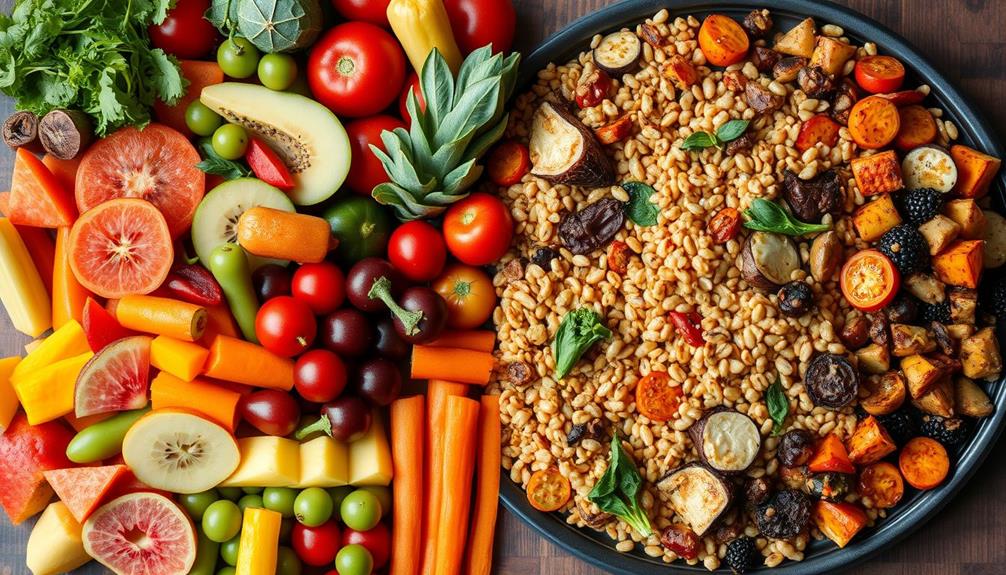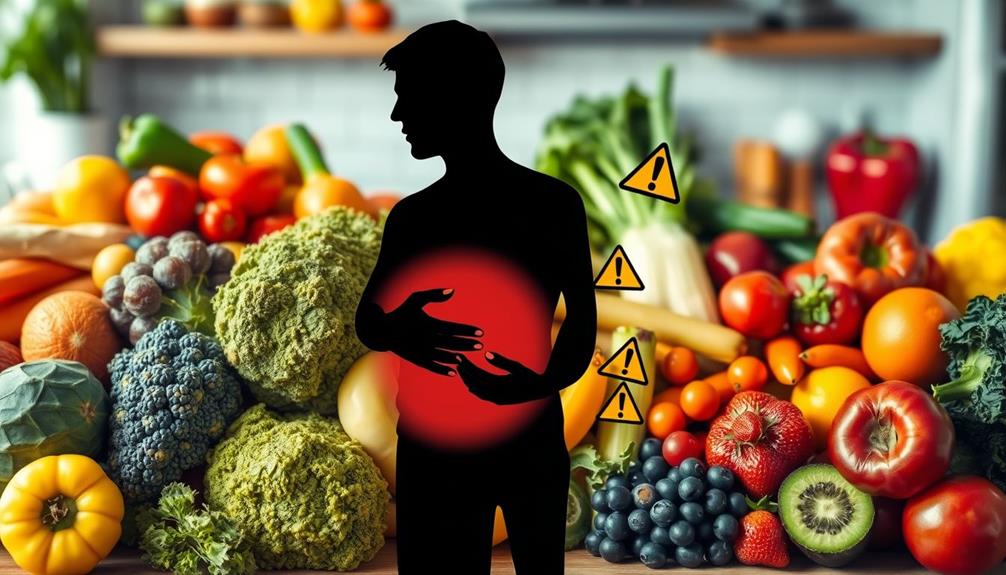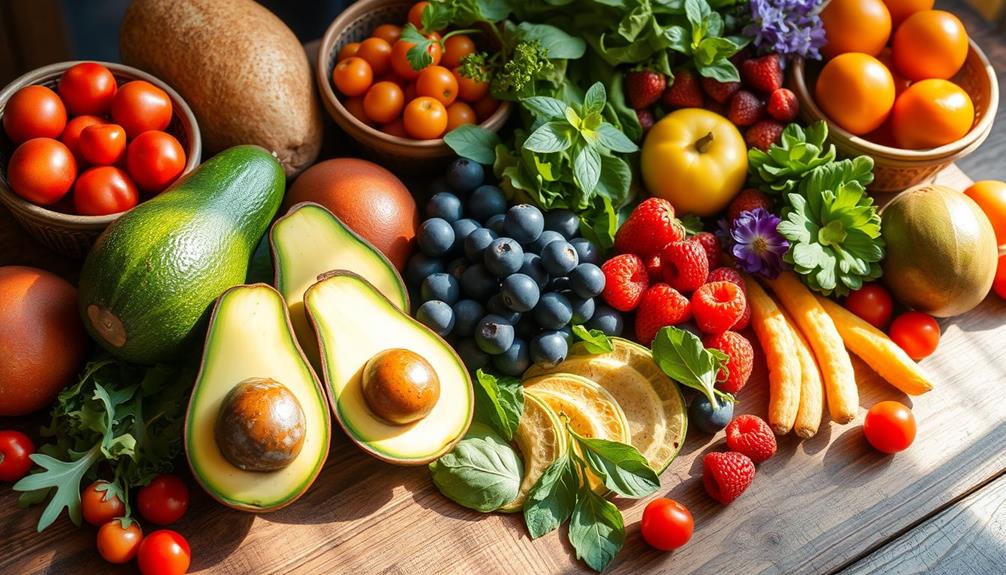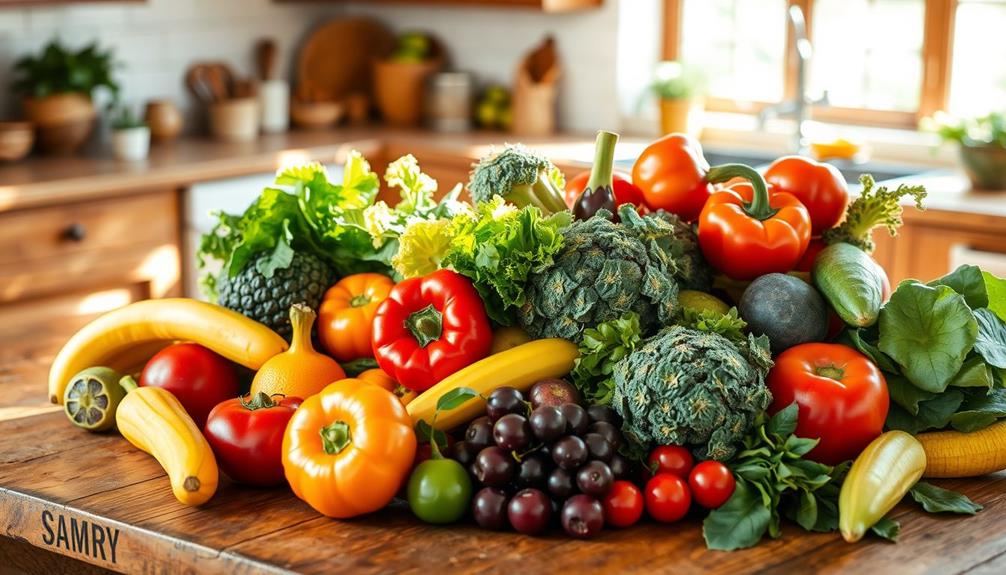When you compare raw and cooked foods, you'll find significant differences in calories and nutrient absorption. Cooking often enhances digestibility, allowing your body to absorb more calories from food compared to raw options. For instance, cooked foods might yield higher caloric absorption, while raw foods can contain beneficial enzymes that cooking destroys. Additionally, moisture loss during cooking typically reduces food weight, complicating your calorie tracking. Weighing your food raw gives a clearer picture of caloric and macronutrient intake, which is essential for effective dieting. Explore how these factors impact your overall nutrition and dietary choices.
Key Takeaways
- Cooking generally increases caloric absorption due to enhanced digestibility compared to raw foods.
- Raw foods may contain anti-nutrient compounds that cooking can reduce or eliminate, affecting nutrient availability.
- Weight loss during cooking, usually around 25%, complicates accurate calorie tracking of cooked foods.
- Measuring raw ingredients is crucial for precise caloric and macronutrient assessment in diets.
- Cooking methods impact nutritional value; steaming retains more nutrients compared to boiling or frying.
Understanding Caloric Measurements
When you track your diet, understanding how caloric measurements work is vital. Traditional methods assign 4 calories per gram of protein and carbohydrates, and 9 calories per gram of fat. However, these figures can be misleading. They don't account for the energy your body uses during digestion, which can lead to inaccuracies in your dietary tracking.
Additionally, certain foods, such as fruits and vegetables, may offer unique health benefits that can complement your diet while also impacting overall caloric intake, similar to the nutritional adjustments for gout.
When comparing raw and cooked foods, cooking methods can drastically change caloric content. Cooking often increases digestibility, meaning you absorb more calories from cooked foods than from their raw counterparts. For example, boiling or baking can cause notable water weight loss, affecting the perceived caloric density of what you eat.
Moreover, discrepancies in calorie labeling reveal that actual caloric intake might be underestimated by about 20%. This emphasizes the need for accurate caloric data when tracking your diet.
To guarantee consistency, weigh your food in its raw state, as the variability in food preparation and ingredient quality can considerably alter caloric values. By understanding these nuances, you can make more informed choices about your diet and better manage your caloric intake.
Impact of Cooking on Calories
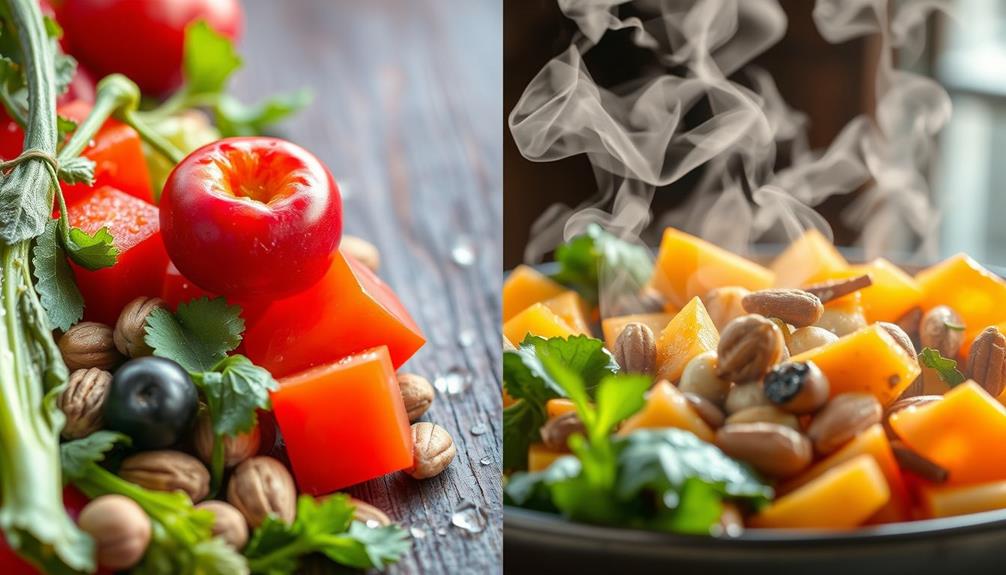
When you cook food, its caloric density can change notably, impacting how many calories you consume.
For instance, the method of preparation can influence the nutrient retention and overall health benefits of your meals, much like brewing methods affect caffeine levels in coffee and tea different brewing methods.
Cooking methods also affect digestibility and nutrient absorption, which can lead to different nutritional outcomes.
Understanding these factors is essential for accurately tracking your caloric intake and managing your weight.
Caloric Density Changes
Cooking notably alters the caloric density of various foods, impacting how your body absorbs and processes them. When you compare raw vs cooked foods, you'll notice that cooking can considerably change their caloric content. For instance, cooking meat helps gelatinize collagen proteins, enhancing calorie absorption and increasing the estimated caloric value per serving.
Similarly, certain cooking methods can enhance the bioavailability of nutrients, much like how essential oils for respiratory health can support overall wellness.
On the other hand, grains and legumes absorb water during cooking, increasing their weight without changing their caloric content. This can lead to miscalculating your caloric intake if you don't account for it properly.
Similarly, while cooking vegetables like spinach can make nutrients more bioavailable, it may also alter the overall caloric content due to water loss.
It's essential to be aware of these changes, as discrepancies in caloric labeling and measurement can reach as high as 20% underestimation. This emphasizes the need for accurate assessment of calories and macros based on whether you're consuming foods raw or cooked.
Understanding these caloric density changes not only helps you manage your diet better but also allows you to make informed decisions about your meals.
Digestibility and Nutrient Absorption
The changes in caloric density highlighted earlier lead directly to how cooking influences digestibility and nutrient absorption. Cooking breaks down fibrous structures in foods, making it easier for your body to access nutrients. For instance, cooking vegetables can greatly improve the bioavailability of beta-carotene, enhancing nutrient content that your body can absorb.
Research shows that cooked foods often yield higher caloric absorption compared to their raw counterparts. This happens because cooking alters food structures, facilitating digestion. Here's a quick look at how various factors play into digestibility and caloric absorption:
| Food Type | Raw Digestibility | Cooked Digestibility |
|---|---|---|
| Vegetables | Low | High |
| Starches | Moderate | High |
| Meats | Low | High |
As you can see, the degree of caloric increase varies by food type and cooking method. Additionally, your gut microbiome reacts differently to cooked versus raw foods, further influencing how much energy you extract from your meals. Ultimately, the impact of cooking on digestibility can greatly affect your caloric intake.
Cooking Methods Comparison
Different cooking methods impact the caloric content of foods in significant ways. When you cook meat, for instance, it often loses moisture. A 225g raw tenderloin steak may shed around 50g of water during cooking, which increases its caloric density per gram compared to raw meat. This moisture loss can make it easier for your body to absorb calories, as the structure of the food changes.
Additionally, incorporating a balanced diet rich in fruits and vegetables can further enhance your overall health, especially when considering the caloric impact of different cooking methods significance of sustainable weight loss.
On the other hand, foods like rice and pasta absorb water while cooking, increasing their weight without adding calories. If you don't adjust your portion sizes when tracking calories, you might miscount your intake.
Research shows that the caloric values assigned to cooked foods may not accurately reflect actual absorption rates. Cooking methods also play a vital role; longer cooking times can diminish nutrient content, while quicker methods like steaming often retain more nutrients and caloric integrity.
Ultimately, understanding these differences helps you make informed choices about your meals and manage your calorie intake more effectively.
Nutritional Differences in Food
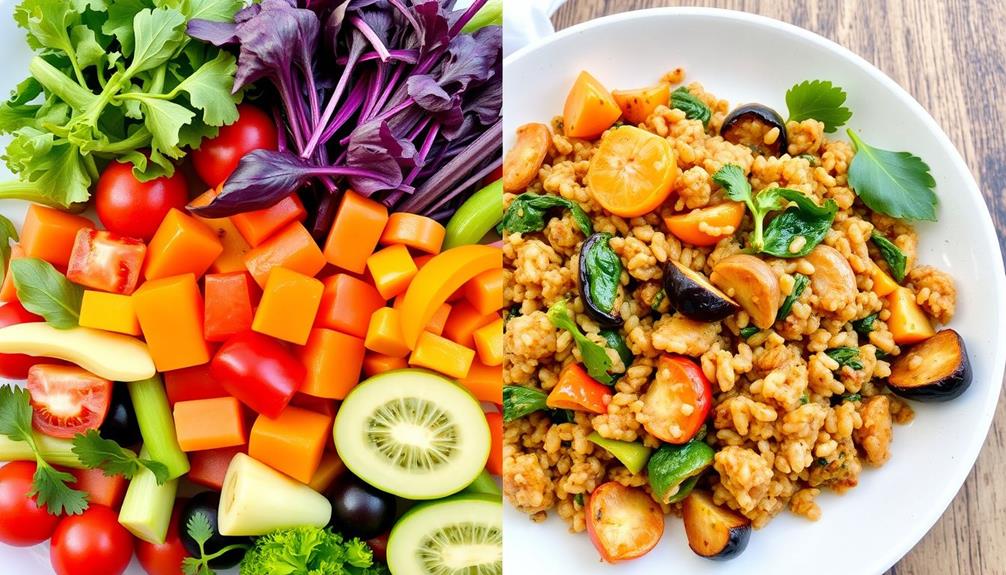
Exploring nutritional differences in food reveals a complex relationship between raw and cooked options. Cooking can enhance the bioavailability of certain nutrients, such as lycopene in tomatoes and beta-carotene in carrots, making these nutrients more accessible in cooked food compared to raw food.
However, it's crucial to note that cooking can considerably reduce water-soluble vitamins, like vitamin C and B vitamins, sometimes leading to a loss of 50-60% during boiling. Additionally, a variety of vegetables, like beetroot characteristics, offer unique nutritional profiles that can be affected by cooking methods.
On the flip side, some raw foods, such as broccoli and cabbage, contain enzymes with anti-cancer properties that cooking destroys. This highlights the nutritional benefits of consuming these vegetables raw.
Additionally, cooking breaks down fibrous structures in foods, improving digestibility and nutrient absorption, particularly in grains and legumes, while also reducing anti-nutrient content.
It's important to remember that the method of cooking influences nutritional value. Steaming and stir-frying generally preserve more nutrients compared to prolonged boiling or frying.
The Role of Gut Bacteria
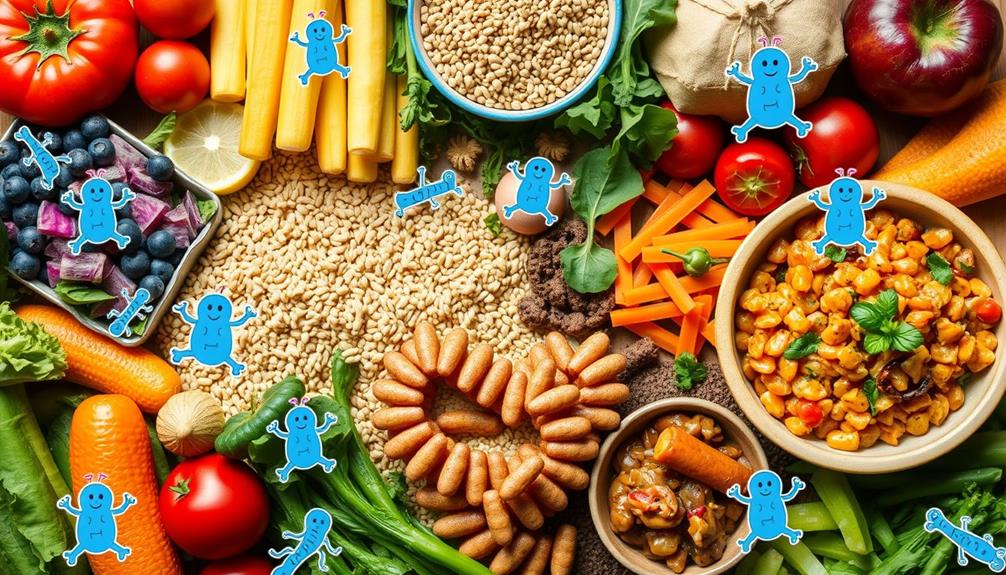
Gut bacteria play an essential role in how your body processes food, influencing everything from digestion to energy extraction. The composition of your gut bacteria varies greatly based on your dietary choices, particularly between raw vs cooked foods.
When you choose raw foods, you're likely to promote a different community of gut bacteria compared to a diet rich in processed and cooked options. Regular consumption of raw foods may also enhance the absorption of nutrients, which is critical for maintaining a healthy microbiome and overall well-being.
Research indicates that diets high in raw foods can enhance the diversity of your gut microbiome, which directly impacts the efficiency of caloric absorption during digestion. In studies, mice fed raw diets showed distinct gut bacterial profiles that improved nutrient utilization, hinting at a possible link between raw food consumption and better metabolic health for you as well.
Your gut bacteria are essential for breaking down complex carbohydrates and fibers found in raw foods, greatly influencing overall energy extraction and calorie availability.
By understanding the interactions between your gut microbiota and the types of food you consume, you can make informed dietary choices that optimize caloric absorption and enhance your overall health benefits.
Additionally, essential oils for skin conditions can support holistic health by addressing external factors that affect well-being.
Accurate Weighing Techniques
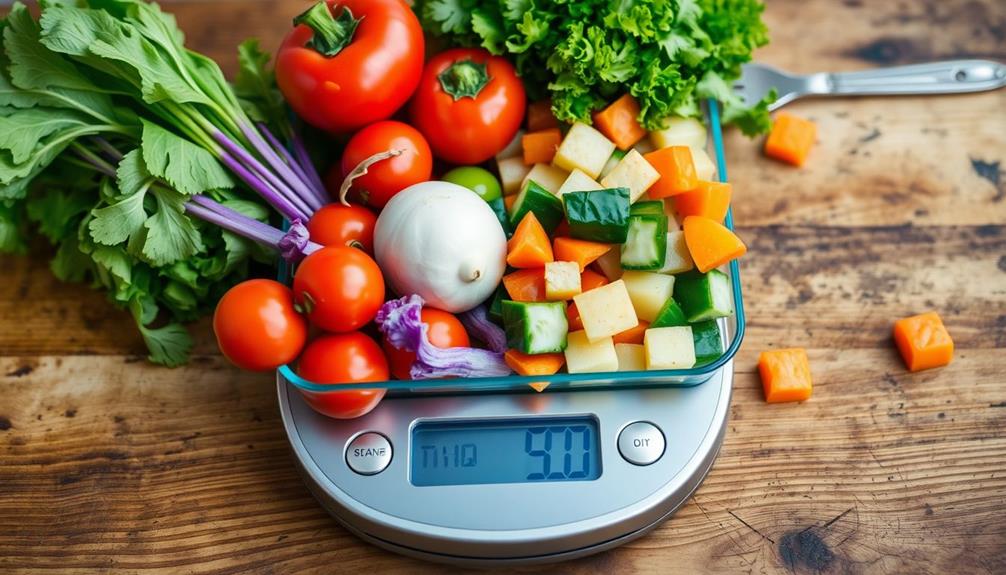
When you weigh your food, measuring raw ingredients is vital for accurate caloric and macronutrient data.
Understanding the impact of personal growth resources on your lifestyle choices can also enhance your approach to food tracking.
Cooking can greatly alter the weight and nutrient composition, leading to potential miscalculations.
To keep your tracking precise, it's important to adopt consistent measuring techniques that account for these changes.
Weighing Raw Ingredients
Accurate weighing techniques play an essential role in tracking your dietary intake effectively. When you're weighing food, it's best to measure ingredients while they're raw. This approach helps you capture a consistent macro content, avoiding discrepancies that cooking methods can introduce.
Cooking often leads to moisture loss; for instance, meats can lose about 25% of their water weight when cooked. This change affects the overall weight and, consequently, the calorie counts. Using raw food benefits, you can maximize nutrient absorption and enhance your dietary experience.
To guarantee you're estimating your calories correctly, you can convert cooked weights back to raw weights by multiplying the raw weight by 0.75. This conversion is particularly useful when dining out or tracking meals at home.
Raw ingredients retain their full caloric and macronutrient content, making them more reliable for your dietary management. If you use cooked weights, you might misestimate your intake due to variations in weight and digestibility.
Cooking Impact on Weight
Often, cooking impacts the weight of food greatly, which can lead to inaccuracies in your dietary tracking. When you cook food, moisture loss typically reduces the weight of meats and vegetables by about 25%. This means that if you're weighing cooked food, you might be getting misleading caloric and macronutrient data.
Weighing raw ingredients provides more accurate information since cooking methods like broiling, baking, and sautéing have similar effects on mass reduction. Additionally, understanding financial terms related to budgeting can help you allocate funds for healthier food options, enhancing your overall diet.
To estimate the raw weight from cooked food, simply multiply the cooked weight by 0.75. This adjustment accounts for average water loss during cooking. However, certain foods like rice, pasta, and beans can actually increase in weight due to water absorption, though their caloric content doesn't change. This adds another layer of complexity when tracking your intake.
Accumulated inaccuracies in tracking cooked food can considerably impact your overall caloric estimates. As a result, prioritizing weighing food in its raw state is essential for effective dietary management.
Measuring Techniques for Accuracy
Understanding how to measure food accurately is key to maintaining a balanced diet. When it comes to raw vs cooked foods, weighing your ingredients in their raw state often provides the most reliable macronutrient data. Cooking can lead to moisture loss, which complicates calorie tracking.
For instance, meats typically lose around 25% of their weight during cooking, which is similar to how early detection is vital in managing health issues like breast cancer, as highlighted in mammography guidelines. If you're using cooked weights, you might misestimate calories and macros, as the caloric content doesn't change.
To guarantee accuracy, when you do measure cooked foods, remember to convert back to raw equivalents. You can easily estimate raw weight by multiplying the cooked weight by 1.33, or by dividing by 0.75. This technique helps you track your intake more precisely.
For foods such as rice, oats, and pasta, it's important to measure them in their cooked state since they absorb water and gain weight. Consistently using raw weights for your tracking can prevent cumulative inaccuracies over time, making sure you meet your dietary goals effectively.
Practical Implications for Dieting
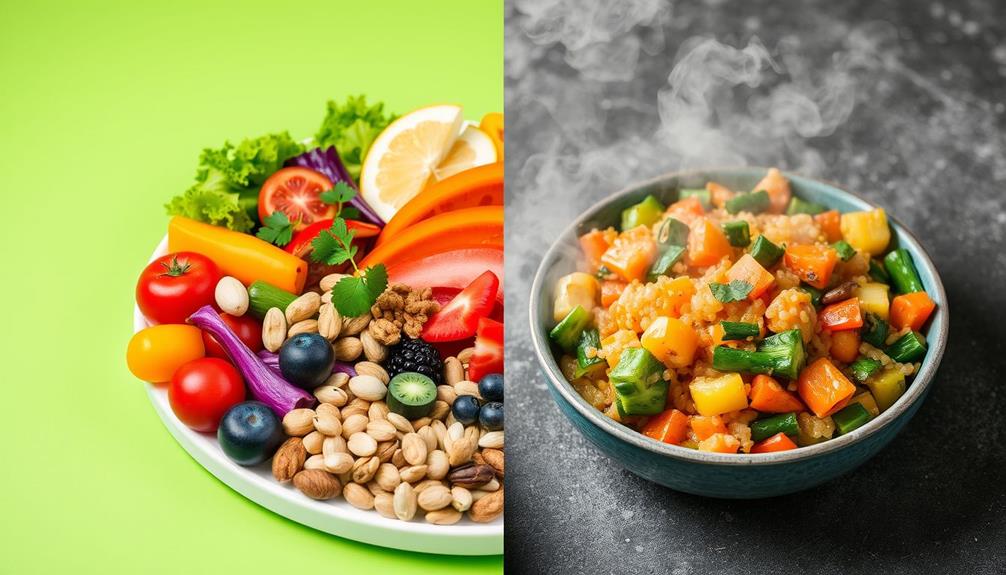
When you weigh food raw, it provides a clearer picture of your calorie and macronutrient intake, which is vital for effective dieting. The discrepancy between raw vs. cooked food can greatly impact your results.
Cooking methods often lead to moisture loss, making cooked foods denser in calories and altering their macronutrient profiles. For instance, a 225g raw tenderloin steak can lose about 25% of its weight during cooking, resulting in an underestimation of calories if you track it after cooking.
When you digest food that's been cooked, your body may absorb calories more efficiently due to improved digestibility. This can lead to a calorie discrepancy of around 250 kcal compared to the accurate measurement of 320 kcal when weighed raw.
To maintain accurate tracking, understanding how to convert cooked weights back to raw estimates is fundamental. Even small miscalculations can accumulate, ultimately derailing your dieting efforts.
Frequently Asked Questions
Does Raw Food Have the Same Calories as Cooked Food?
Raw food doesn't have the same calories as cooked food. Cooking often reduces water content, making foods denser and potentially higher in calories, while also enhancing nutrient absorption, which affects your overall calorie intake. In general, raw fruits and vegetables have a lower calorie content than cooked versions, as cooking can break down the cell walls and release more of the natural sugars and calories. However, this is not always the case, as some foods become more calorie-dense when cooked, such as with grains and legumes. It is important to consider the raw vs cooked calorie comparison when planning a balanced and nutritious diet.
Is It Better to Count Calories Cooked or Uncooked?
You should count calories based on how you consume the food. If you eat it cooked, track those values for accuracy. Just remember that cooking can change calorie content, so stay mindful of those adjustments.
Does Raw Food Have Less Calories?
Yes, raw foods generally have fewer calories because they contain more water, which reduces their overall caloric density. However, cooking can enhance nutrient availability, potentially increasing calorie content and making some foods easier to digest.
Are Calories Calculated on Raw or Cooked Meat?
When it comes to calorie counting, it's like trying to catch smoke with your bare hands; you've gotta focus on raw meat. Measuring it raw gives you the most accurate calorie count for your meals.
Conclusion
So, whether you're crunching on raw carrots or munching on roasted ones, just remember: calories might be playing a sneaky game of hide and seek. Cooking can change their numbers, but it's not like they're going to throw you a party for eating them! Keep an eye on your gut bacteria, weigh your food like a pro, and maybe just enjoy your meals without overthinking. After all, life's too short to count every single calorie—unless you're a mathematician!

